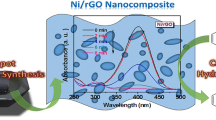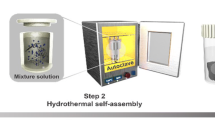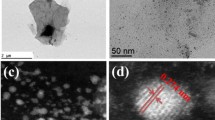Abstract
Here in this article, we report an eco-friendly approach for in situ synthesis of MNPs implanted on reduced graphene oxide (MNPs@rGO) [where MNPs = Metal nanoparticles such as vanadium oxide (VO), Nickel (Ni) and Copper (Cu)] nanocatalysts. These composite materials were well corroborated through diverse physicochemical techniques. Noticeably, MNPs@rGO promoted hydrogenolysis of benzyl alcohol (BzA) with triethylsilane (Et3SiH) as a reductant bestowing exceptional activity to provide synthetically valuable hydrocarbon product i.e. toluene. The impact of discrete experimental variables like mole ratio, catalyst amount, reaction time and solvents have also been examined. Under the optimized conditions, CuNPs@rGO exclusively promoted the preceding reaction leading to 81.2% conversion of BzA with 99.9% toluene selectivity. Additionally, it could be recycled and reused without consequential loss of activity in the fifth cycle tests.












Similar content being viewed by others
References
Centi G, Perathoner S (2003) Catalysis and sustainable (green) chemistry. Catal Today 77:287–297
Clark JH, Macquarrie DJ (1997) Heterogeneous catalysis in liquid phase transformations of importance in the industrial preparation of fine chemicals. Org Process Res Dev 1:149–162
Wang Y, Wang X, Antonietti M (2012) Polymeric graphitic carbon nitride as a heterogeneous organocatalyst: from photochemistry to multipurpose catalysis to sustainable chemistry. Angew Chemie Int Ed 51:68–89
Dhakshinamoorthy A, Alvaro M, Garcia H (2011) Metal-organic frameworks as heterogeneous catalysts for oxidation reactions. Catal Sci Technol 1:856–867
Habibi D, Faraji AR, Arshadi M, Fierro JLG (2013) Characterization and catalytic activity of a novel Fe nano-catalyst as efficient heterogeneous catalyst for selective oxidation of ethylbenzene, cyclohexene, and benzylalcohol. J Mol Catal A Chem 372:90–99
Maurya M, Kumar A, Costa Pessoa J (2011) Vanadium complexes immobilized on solid supports and their use as catalysts for oxidation and functionalization of alkanes and alkenes. Coord Chem Rev 255:2315–2344
Zapf A, Beller M (2002) Fine chemical synthesis with homogeneous palladium catalysts: examples, status and trends. Top Catal 19:101–109
Yoon M, Srirambalaji R, Kim K (2012) Homochiral metal-organic frameworks for asymmetric heterogeneous catalysis. Chem Rev 112:1196–1231
Sudarsanam P, Katta L, Thrimurthulu G, Reddy BM (2013) Vapor phase synthesis of cyclopentanone over nanostructured ceria-zirconia solid solution catalysts. J Ind Eng Chem 19:1517–1524
Kim K-H, Ihm S-K (2011) Heterogeneous catalytic wet air oxidation of refractory organic pollutants in industrial wastewaters: a review. J Hazard Mater 186:16–34
Kajbafvala A, Ghorbani H, Paravar A et al (2012) Effects of morphology on photocatalytic performance of Zinc oxide nanostructures synthesized by rapid microwave irradiation methods. Superlattices Microstruct 51:512–522
Sakurai H, Tsukuda T, Hirao T (2002) Pd/C as a reusable catalyst for the coupling reaction of halophenols and arylboronic acids in aqueous media. J Org Chem 67:2721–2722
Chen X, Hou Y, Wang H et al (2008) Facile deposition of Pd nanoparticles on carbon nanotube microparticles and their catalytic activity for suzuki coupling reactions. J Phys Chem C 112:8172–8176
Biffis A, Zecca M, Basato M (2001) Metallic palladium in the heck reaction: active catalyst or convenient precursor? Eur J Inorg Chem 2001:1131–1133
Bedford RB, Singh UG, Walton RI et al (2005) Nanoparticulate palladium supported by covalently modified silicas: synthesis, characterization, and application as catalysts for the suzuki coupling of aryl halides. Chem Mater 17:701–707
Modi CK, Panwala S, Vithalani R, Patel D (2018) Ionic liquid infiltrated within metal loaded zeolites for Baeyer–Villiger oxidation reaction under solvent-free condition. J Porous Mater 25:871–883
Modi CK, Solanki N, Vithalani R, Patel D (2017) Baeyer–Villiger oxidation of cyclopentanone over zeolite Y entrapped transition metal-Schiff base complexes. Appl Organometal Chem 32:3910–3923
Modi CK, Vithalani R, Patel DS, Som NN, Jha P (2018) Zeolite-Y entrapped metallo-pyrazolone complexes as heterogeneous catalysts: synthesis, catalytic aptitude and computational investigation. Micropor Mesopor Mater 261:275–285
Modi CK, Trivedi P (2014) Advanced energy materials. In: Tiwari A, Valyukh S (eds) There’s plenty of room in the field of zeolite-Y enslaved nanohybrid materials as eco-friendly catalysts: selected catalytic reaction. Scrivener Publishing, Wiley, Beverly, pp 555–583
Baloyi J, Ntho T, Moma J (2019) Synthesis of highly active and stable Al/Zr pillared clay as catalyst for catalytic wet oxidation of phenol. J Porous Mater 26:583–597
Singh AS, Patil UB, Nagarkar JM (2013) Palladium supported on zinc ferrite: a highly active, magnetically separable catalyst for ligand free Suzuki and Heck coupling. Catal Commun 35:11–16
Modi CK, Vithalani R, Patel D (2018) Graphene oxide: advances in research and applications. In: Mishra A, Pathania D (eds) An immense uprising: functionalization and fine-tuning of 2D graphene designed for heterogeneous catalysis to make things greener. NOVA Science Publishers, USA, pp 217–244
Zhang W-H, Zhou Y-C, Du C-H, Gao M, Liu S-S, Liu P, Li Y-X (2019) Immobilized amino containing basic ionic liquid on graphene oxide as an efficient and stable catalyst for transesterifcation. React kinet mech cat 127:715–726
Vithalani R, Patel D, Modi CK, Som NN, Jha PK, Kane SR (2018) Enhancing the potency of surface hydroxyl groups of graphene oxide for selective oxidation of benzyl alcohol. Diam Relat Mater 90:154–165
Vithalani R, Patel DS, Modi CK, Sharma V, Jha PK (2020) Graphene oxide supported oxovanadium (IV) complex for catalytic peroxidative epoxidation of styrene: an eye-catching impact of solvent. Appl Organomet Chem 34:e5500
Geim AK, Novoselov KS (2007) The rise of graphene. Nat Mater 6:183
Geim AK (2009) Graphene: status and prospects. Science 80(324):1530–1534
Zheng X-C, Li N, Jiang S et al (2019) Preparation and catalytic performance of tungstophosphoric acid anchored to SiO2@graphene aerogel 3D porous catalysts for the synthesis of ethyl levulinate biofuel. J Porous Mater 26:723–732
Patel D, Vithalani R, Modi CK (2020) Highly efficient FeNP-embedded hybrid bifunctional reduced graphene oxide for Knoevenagel condensation with active methylene compounds. New J Chem 44:2868–2881
Salavati-Niasari M, Davar F, Loghman-Estarki MR (2009) Long chain polymer assisted synthesis of flower-like cadmium sulfide nanorods via hydrothermal process. J Alloys Compd 481:776–780
Salavati-Niasari M, Dadkhah M, Davar F (2009) Synthesis and characterization of pure cubic zirconium oxide nanocrystals by decomposition of bis-aqua, tris-acetylacetonato zirconium (IV) nitrate as new precursor complex. Inorganica Chim Acta 362:3969–3974
Safajou H, Khojasteh H, Salavati-Niasari M, Mortazavi-Derazkola S (2017) Enhanced photocatalytic degradation of dyes over graphene/Pd/TiO2 nanocomposites: TiO2 nanowires versus TiO2 nanoparticles. J Colloid Interface Sci 498:423–432
Mohandes F, Salavati-Niasari M (2013) Sonochemical synthesis of silver vanadium oxide micro/nanorods: solvent and surfactant effects. Ultrason Sonochem 20:354–365
Mahdiani M, Soofivand F, Ansari F, Salavati-Niasari M (2018) Grafting of CuFe12O19 nanoparticles on CNT and graphene: eco-friendly synthesis, characterization and photocatalytic activity. J Clean Prod 176:1185–1197
Esmaeili-Zare M, Salavati-Niasari M, Sobhani A (2012) Simple sonochemical synthesis and characterization of HgSe nanoparticles. Ultrason Sonochem 19:1079–1086
Davar F, Salavati-Niasari M, Mir N et al (2010) Thermal decomposition route for synthesis of Mn3O4 nanoparticles in presence of a novel precursor. Polyhedron 29:1747–1753
Ji Z, Wang Y, Shen X et al (2017) Facile synthesis and enhanced catalytic performance of reduced graphene oxide decorated with hexagonal structure Ni nanoparticles. J Colloid Interface Sci 487:223–230
Barton DHR, McCombie SW (1975) A new method for the deoxygenation of secondary alcohols. J Chem Soc Perkin Trans 1:1574–1585
Heravi MM, Bakhtiari A, Faghihi Z (2014) Applications of Barton–McCombie reaction in total syntheses. Curr Org Synth 11:787–822
Mirza-Aghayan M, Boukherroub R, Rahimifard M (2009) A simple and efficient hydrogenation of benzyl alcohols to methylene compounds using triethylsilane and a palladium catalyst. Tetrahedron Lett 50:5930–5932
Mirza-Aghayan M, Molaee Tavana M, Boukherroub R (2015) Palladium nanoparticles supported on reduced graphene oxide as an efficient catalyst for the reduction of benzyl alcohol compounds. Catal Commun 69:97–103
Liu P, Chang WT, Wu M-Y, Xi Y-X, Wang J (2015) A highly efficient Pd/graphene oxide catalyst with abundant oxygen groups for the hydrogenation. React kinet mech cat 116:409–419
Lost KN, Borisov VA, Temerev VL, Smirnova NS, Surovikin YV et al (2019) Effect of the carbon support graphitization on the activity and thermal stability of Ru–Ba–Cs/C ammonia decomposition catalysts. React kinet mech cat 127:85–102
Chatgilialoglu C, Ferreri C, Lucarini M (1993) A comment on the use of triethylsilane as a radical-based reducing agent. J Org Chem 58:249–251
Keinan E, Greenspoon N (1986) Highly chemoselective palladium-catalyzed conjugate reduction of. alpha., beta.-unsaturated carbonyl compounds with silicon hydrides and zinc chloride cocatalyst. J Am Chem Soc 108:7314–7325
Ojima I, Kogure T, Nagai Y (1973) A novel method for the reduction of Schiff bases using catalytic hydrosilylation. Tetrahedron Lett 14:2475–2478
Chan LY, Lim JSK, Kim S (2011) Iron-catalyzed reductive dehydroxylation of benzylic alcohols using polymethylhydrosiloxane (PMHS). Synlett 2011:2862–2866
Egi M, Kawai T, Umemura M, Akai S (2012) Heteropolyacid-catalyzed direct deoxygenation of propargyl and allyl alcohols. J Org Chem 77:7092–7097
Mirza-Aghayan M, Boukherroub R, Bolourtchian M, Rahimifard M (2007) Palladium catalyzed mild reduction of α, β-unsaturated compounds by triethylsilane. J Organomet Chem 692:5113–5116
Mirza-Aghayan M, Boukherroub R, Rahimifard M (2008) Efficient method for the reduction of carbonyl compounds by triethylsilane catalyzed by PdCl2. J Organomet Chem 693:3567–3570
Paulchamy B, Arthi G, Lignesh BD (2015) A simple approach to stepwise synthesis of graphene oxide nanomaterial. J Nanomed Nanotechnol 6:253–256
Moon G-h, Park Y, Kim W, Choi W (2011) Photochemical loading of metal nanoparticles on reduced graphene oxide sheets using phosphotungstate. Carbon 49:3454–3462
Hussain N, Gogoi P, Azhaganand VK et al (2015) Green synthesis of stable Cu(0) nanoparticles onto reduced graphene oxide nanosheets: a reusable catalyst for the synthesis of symmetrical biaryls from arylboronic acids under base-free conditions. Catal Sci Technol 5:1251–1260
Zhang C, Chen M, Xu X et al (2014) Graphene oxide reduced and modified by environmentally friendly glycylglycine and its excellent catalytic performance. Nanotechnology 25:135707
Darabdhara G, Boruah PK, Borthakur P et al (2016) Reduced graphene oxide nanosheets decorated with Au–Pd bimetallic alloy nanoparticles towards efficient photocatalytic degradation of phenolic compounds in water. Nanoscale 8:8276–8287
Yang Y, Lu Z-H, Hu Y et al (2014) Facile in situ synthesis of copper nanoparticles supported on reduced graphene oxide for hydrolytic dehydrogenation of ammonia borane. RSC Adv 4:13749–13752
Mondal P, Sinha A, Salam N et al (2013) Enhanced catalytic performance by copper nanoparticle–graphene based composite. RSC Adv 3:5615–5623
Li Y, Zhang R, Tian X, Yang C, Zhou Z (2016) facile synthesis of Fe3O4 nanoparticle decorated on 3D graphene aerogels as broad-spectrum sorbents for water treatment. Appl Surf Sci 369:11
Li Y, Li Z, Shen PK (2013) Simultaneous formation of ultrahigh surface area and three-dimensional hierarchical porous graphene-like networks for fast and highly stable supercapacitors. Adv Mater 25:2474–2480
Babitha KB, Jani Matilda J, Peer Mohamed A, Ananthakumar S (2015) Catalytically engineered reduced graphene oxide/ZnO hybrid nanocomposites for the adsorption, photoactivity and selective oil pick-up from aqueous media. RSC Adv 5:50223–50233
Reichardt C, Welton T (2011) Solvents and solvent effects in organic chemistry. Wiley, Weinheim
Pandarus V, Ciriminna R, Gingras G et al (2018) Hydrogenolysis of C−O chemical bonds of broad scope mediated by a new spherical sol-gel catalyst. ChemistryOpen 7:80–91
Zhang J, Dong K, Luo W, Guan H (2018) Selective transfer hydrogenation of furfural into furfuryl alcohol on Zr-containing catalysts using lower alcohols as hydrogen donors ACS. Omega 3:6206–6216
Marella RK, Neeli CKP, Kamaraju SRR, Burri DR (2012) Highly active Cu/MgO catalysts for selective dehydrogenation of benzyl alcohol into benzaldehyde using neither O2 nor H2 acceptor. Catal Sci Technol 2:1833–1838
Lin H-W, Yen CH, Tan C-S (2012) Aromatic hydrogenation of benzyl alcohol and its derivatives using compressed CO2/water as the solvent. Green Chem 14:682–687
Gross BH, Mebane RC, Armstrong DL (2001) Transfer hydrogenolysis of aromatic alcohols using Raney catalysts and 2-propanol. Appl Catal A Gen 219:281–289
Nimmagadda RD, McRae C (2006) A novel reduction reaction for the conversion of aldehydes, ketones and primary, secondary and tertiary alcohols into their corresponding alkanes. Tetrahedron Lett 47:5755–5758
Acknowledgements
We express our gratitude to the Head, Applied Chemistry Department, Faculty of Technology and Engineering, The Maharaja Sayajirao University of Baroda, Vadodara, Gujarat, India for providing the necessary laboratory facilities. Authors are thankful to the DST-PURSE program for providing Raman measurements. The authors would like to present his deep thanks and gratitude to Dr. R. J. Choudhary, UGC-DAE Consortium for Scientific Research, Indore, MP, India. Analytical facilities provided by the SAIF, IIT, Mumbai, India and the University Sophisticated Instruments Facility (USIF), AMU, Aligarh, UP, India is gratefully acknowledged.
Author information
Authors and Affiliations
Corresponding author
Ethics declarations
Conflict of interest
The author declare that they have no conflict of interest.
Additional information
Publisher's Note
Springer Nature remains neutral with regard to jurisdictional claims in published maps and institutional affiliations.
Rights and permissions
About this article
Cite this article
Patel, D., Vithalani, R.S., Modi, C.K. et al. Metal nanoparticles (MNPs)-decorated reduced graphene oxide nanosheets as efficient catalysts for hydrogenolysis of benzyl alcohol. Graphene and 2D Materials Technol 6, 13–24 (2021). https://doi.org/10.1007/s41127-021-00041-9
Received:
Revised:
Accepted:
Published:
Issue Date:
DOI: https://doi.org/10.1007/s41127-021-00041-9




